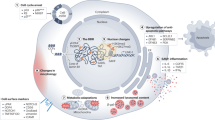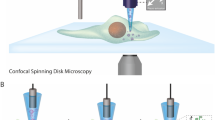Abstract
NUMEROUS differences have been demonstrated between normal and transformed cells in culture. One characteristic finding is the presence of a 2–2.5 × 105 molecular weight externally disposed glycoprotein (fibronectin) on normal cells and its absence from cell surface association in transformed cells (see refs 1–3 for reviews). Transformed human cells are known to synthesise and shed fibronectin, although at a much lower rate than comparable normal cells4,5. Studies using immunofluorescence or immunoperoxidase methods have demonstrated fibronectin in pericellular structures of fibroblasts and myoblasts in what we have termed an extracellular filamentous matrix6. In transformed cells that are producing fibronectin, though at a lower rate, there is a failure to incorporate the glycoprotein into the extracellular matrix. There is also a similar failure to incorporate collagen into a cellular matrix in transformed fibroblasts7. The function of this protein, fibronectin, is thought to be related to cellular adhesiveness and perhaps thereby have some role in cell shape. Transformed cells are less adhesive to each other and to substrates when grown in vitro and upon addition of exogenous fibronectin there is a concomitant increase in adhesiveness and change in cell shape8,9. There are many examples of glucocorticoids modulating differentiation some of which include, liver10, pancreas11, mammary gland12, retina13 and myoblasts14. Recent work in the exocrine pancreas11 suggests that glucocorticoids may induce specific enzymes without altering the level of general cellular proteins. Glucocorticoids have been shown to stimulate proliferation in growth arrested cells15 and modify in a synergistic or inhibitory manner cellular responses to other hormones. We report here the effects of dexamethasone on modifying one phenotypic characteristic of cells, namely the occurrence of an extracellular filamentous matrix consisting of fibronectin and collagen. Based on the old hypothesis that transformed or malignant cells are arrested in differentiation, we consider development of the matrix a manifestation of the differentiated state of fibroblasts.
This is a preview of subscription content, access via your institution
Access options
Subscribe to this journal
Receive 51 print issues and online access
$199.00 per year
only $3.90 per issue
Buy this article
- Purchase on Springer Link
- Instant access to full article PDF
Prices may be subject to local taxes which are calculated during checkout
Similar content being viewed by others
References
Hynes, R. O. Biochim. biophys. Acta 458, 73 (1976).
Vaheri, A. & Mosher, D. F. Biochim. biophys. Acta 516, 1 (1978).
Yamada, K. & Olden, K. Nature 275, 179 (1978).
Mosher, D. F., Saksela, A., Keski-Oja, J. & Vaheri, A. J. Supramolec. Struct. 6, 551 (1977).
Vaheri, A., Ruoslahti, E., Westermaark, B. & Ponten, J. J. exp. Med. 143, 64 (1976).
Furcht, L. T., Mosher, D. F. & Wendelschafer-Crabb, G. Cell 13, 263 (1978).
Arbogast, B. W., Yoshimura, M., Kefalides, N. A. & Holtzer, H. J. biol. Chem. 252, 8863 (1977).
Ali, I. U., Mautner, V., Lanza, R. & Hynes, R. O. Cell 11, 115 (1977).
Yamada, K. M., Ohanian, S. H. & Pastan, I. Cell 9, 241 (1976).
Eisen, H. J., Goldfine, I. D. & Glinsman, W. H. Proc. natn. Acad. Sci. U.S.A. 70, 3454 (1973).
Rall, L., Pictet, R., Githens, S. & Rutter, W. J. J. Cell Biol. 75, 398 (1977).
Mills, E. S. & Topper, H. J. J. Cell Biol. 44, 310 (1970).
Moscona, A. in Hormones in Development (eds Hamburg M. & Barrington, E. J. W.) 169–189 (Appleton Century-Crofts, New York, 1971).
Furcht, L. T., Wendelschafer-Crabb, G. & Woodbridge, P. J. Supramolec. Struct. 7, 307 (1977).
Thrash, C. R. & Cunningham, D. D. Nature 242, 399 (1973).
Furcht, L. T., Mosher, D. F. & Wendelschafer-Crabb, G. Cancer Res. 38, 4618 (1978).
Chen, L. B., Gudor, R. D., Sun, T. T., Chen, A. & Mosesson, M. W. Science 197, 776–778 (1977).
Porter, K. R., Todaro, G. J. & Fonte, V. J. Cell Biol. 59, 633–642 (1973).
Green, H. & Kehinde, O. Cell 7, 105–114 (1976).
Boone, C. W. Science 188, 68–70 (1975).
Adams, S. et al. Proc. natn. Acad. Sci. U.S.A. 14, 3399 (1977).
Blumberg, P. & Robbins, P. Cell 6, 137 (1975).
Unkeless, J. C. et al. J. exp. Med. 137, 85 (1973).
Vassalli, J. D., Hamilton, J. & Reich, E. Cell 8, 271 (1976).
Wigler, M., Ford, J. P. & Weinstein, I. B. in Proteases and Biological Control (eds Reich, E., Rifkin, D. & Shaw, E.) 849–856 (Cold Spring Harbor Laboratory, New York, 1975).
Greaves, M. W. & McDonald-Gibson, W. J. J. Pharmac. 46, 172 (1972).
Author information
Authors and Affiliations
Rights and permissions
About this article
Cite this article
FURCHT, L., MOSHER, D., WENDELSCHAFER-CRABB, G. et al. Dexamethasone-induced accumulation of a fibronectin and collagen extracellular matrix in transformed human cells. Nature 277, 393–395 (1979). https://doi.org/10.1038/277393a0
Received:
Accepted:
Issue Date:
DOI: https://doi.org/10.1038/277393a0
Comments
By submitting a comment you agree to abide by our Terms and Community Guidelines. If you find something abusive or that does not comply with our terms or guidelines please flag it as inappropriate.



